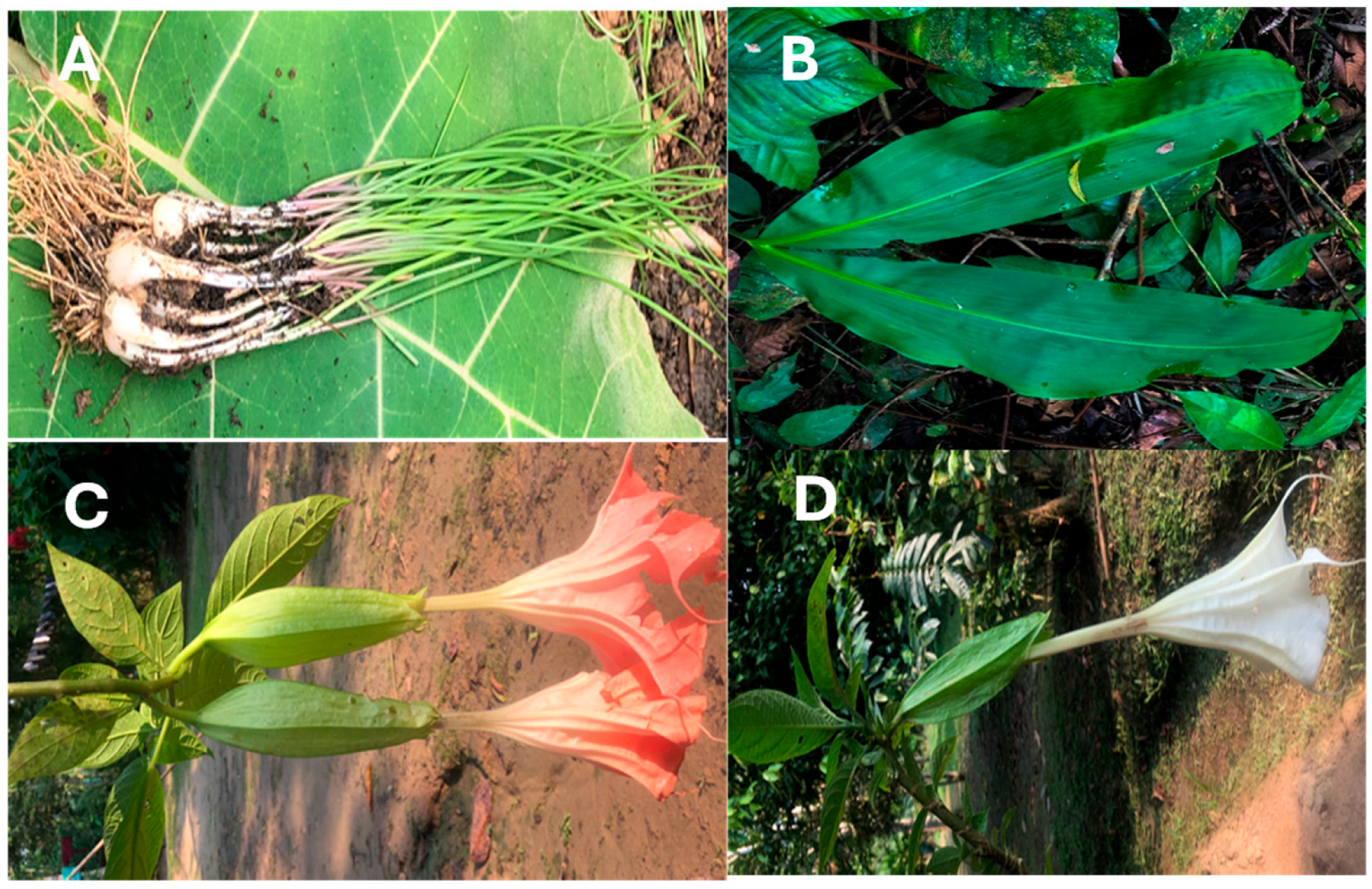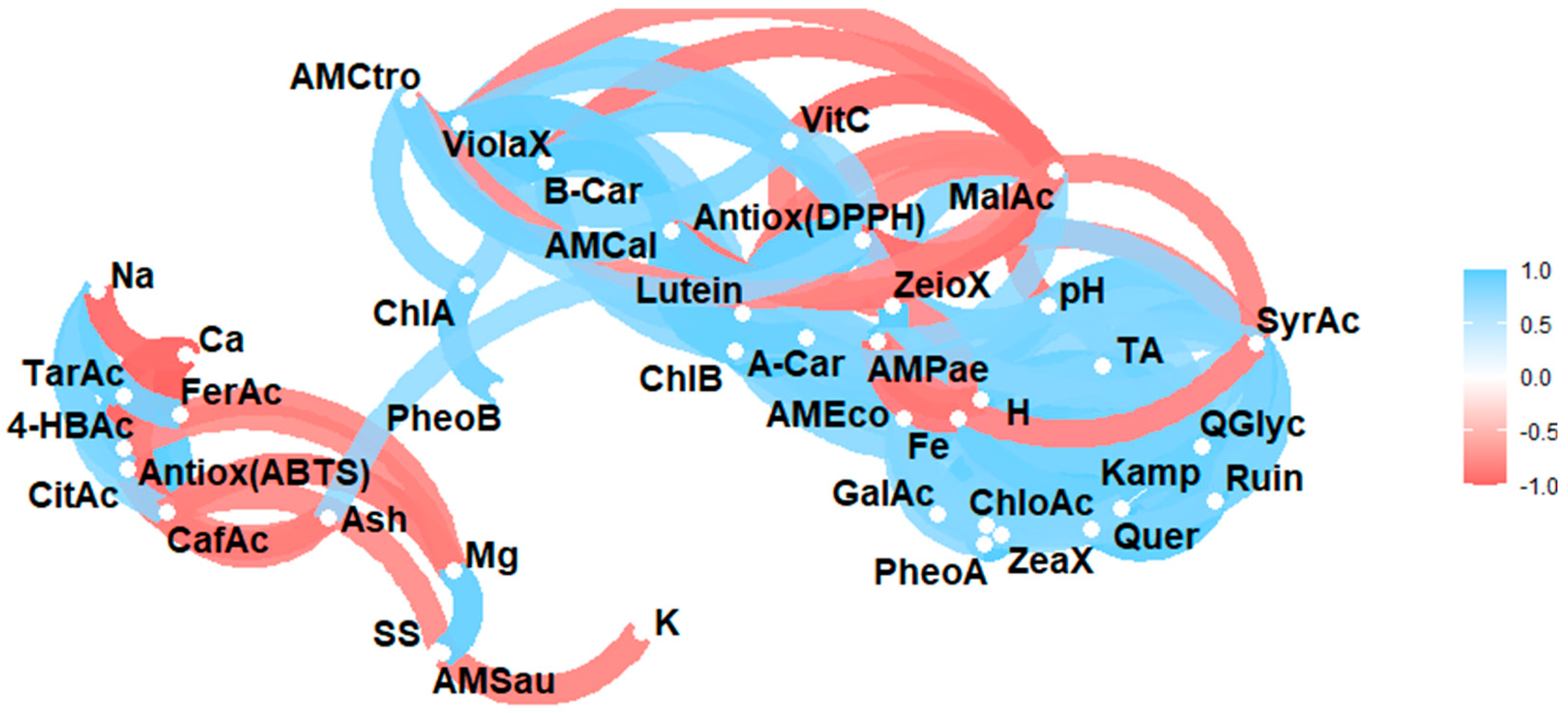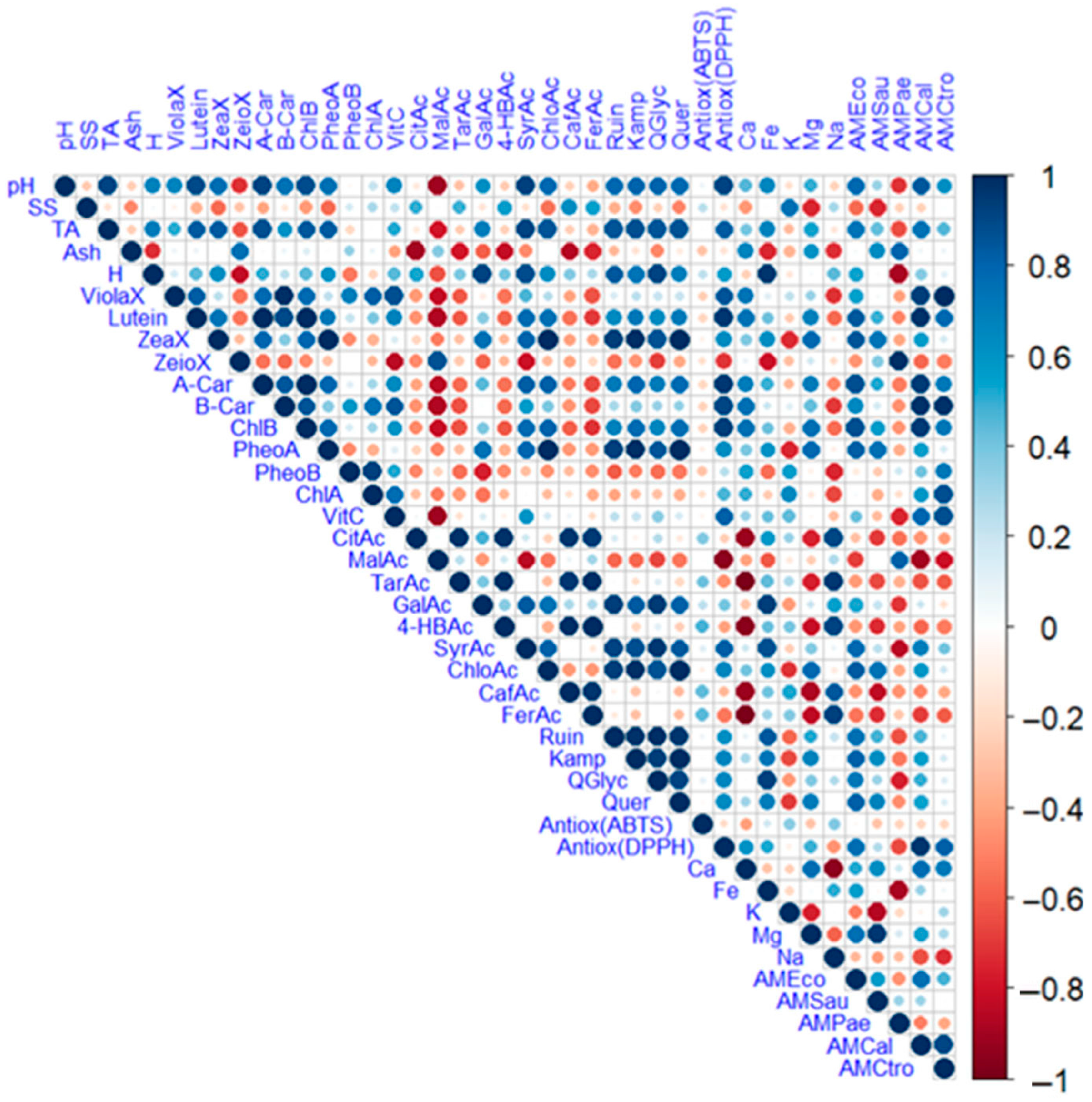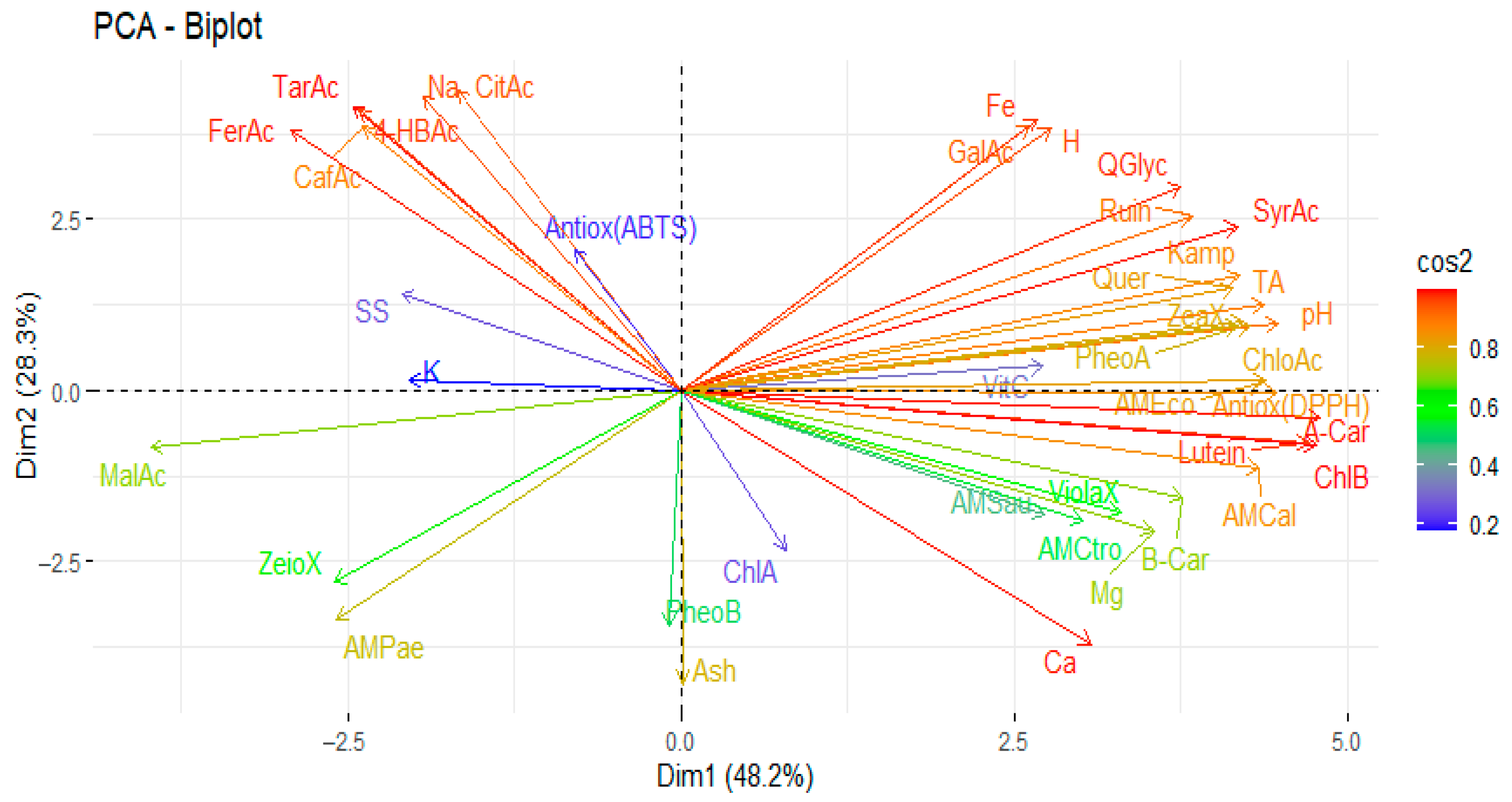Functional, Antioxidant, and Antimicrobial Profile of Medicinal Leaves from the Amazon
Abstract
1. Introduction
2. Materials and Methods
2.1. Reagents and Standards
2.2. Physico-Chemical Analyses
2.2.1. Mineral Profile
2.2.2. Phytochemical Screening
2.3. Analysis of Bioactive Compounds
2.3.1. L-Ascorbic Acid
2.3.2. Organic Acid Profile
2.3.3. Carotenoid Profile
2.3.4. Phenol Profile
2.4. Antioxidant Activity Analyses
2.5. Antimicrobial Activity Analyses
2.5.1. Antibacterial Activity
2.5.2. Antifungal Activity
2.6. Statistical Analysis
3. Results
3.1. Physico-Chemical Characteristics
3.2. Analysis of Bioactive Compounds
3.3. Antioxidant Activity Analyses
3.4. Antimicrobial Activity Analyses
3.5. Statistical Analysis
4. Discussion
4.1. Physico-Chemical Analyses
4.2. Analysis of Bioactive Compounds
4.3. Antioxidant Activity Analyses
4.4. Antimicrobial Activity Analyses
4.5. Statistical Analysis
5. Conclusions
Author Contributions
Funding
Institutional Review Board Statement
Informed Consent Statement
Data Availability Statement
Conflicts of Interest
References
- Guayasamin, J.; Ribas, C.; Carnaval, A.; Carrillo, J.; Hoorn, C.; Lohmann, L.; Riff, D.; Ulloa Ulloa, C.; Albert, J. Evolution of Amazonian Biodiversity: A Review. Acta Amaz. 2024, 54, e54bc21360. [Google Scholar] [CrossRef]
- Medeiros, M.; Albuquerque, U. Local Food Plants of Brazil; Springer Nature: Cham, Switzerland, 2021; ISBN 978-3-030-69139-4. [Google Scholar]
- Zandonadi, A.; Saranz, E.; Buccini, D.; Cardoso, B.; Cerqueira, G.; Moreno, S. Ethnopharmacological and Botanical Evaluation of Medicinal Plants Used by Brazilian Amazon Indian Community. Interações 2020, 21, 633–645. [Google Scholar] [CrossRef]
- Moraes, L.; Freitas, J.; Matos, J.; Silva, R.; Borges, C.; Santos, A. Ethno-Knowledge of Medicinal Plants in a Community in the Eastern Amazon. Rev. Ciências Agrárias 2019, 42, 565–573. [Google Scholar]
- Alves, O.; Castro, I.; Pacheco, E.; Miranda, S.; Ferreira, M.; Lobato, R.; Alves, T.; Batista, A.; Santos, A. Phytochemistry of Medicinal Plants of the Amazon. Methodol. Focus. Area Interdiscip. V1 2023, 1, 54–65. [Google Scholar] [CrossRef]
- Vargas-Arana, G.; Rengifo-Salgado, E.; Simirgiotis, M. Antidiabetic Potential of Medicinal Plants from the Peruvian Amazon: A Review. Bol. Latinoam. Caribe Plantas Med. Aromat. 2023, 22, 277–300. [Google Scholar] [CrossRef]
- Sandoval, A.; Valverde, J.; Calla, K.; Alba, R.; Lloclla, H.; Ismiño, A.; Sotero, S.; Salazar, M. Hydroalcoholic Extracts of Fruit Leaves from the Peruvian Amazon as Antibacterial Potential of Gram-Negative and Gram-Positive Bacteria. Chem. Eng. Trans. 2020, 79, 319–324. [Google Scholar] [CrossRef]
- Sinaga, S.; Sudarmi, S.; Iksen, I.; Kevin, K.; Sari, M. Evaluation of Total Phenolic, Flavonoid Content, Antioxidant and in Vitro Antilithogenesis Activities of Chives Leaf (Allium schoenoprasum, L.). Rasayan J. Chem. 2018, 11, 1604–1608. [Google Scholar] [CrossRef]
- Kurnia, D.; Ajiati, D.; Heliawati, L.; Sumiarsa, D. Antioxidant Properties and Structure-Antioxidant Activity. Molecules 2021, 26, 7175. [Google Scholar] [CrossRef] [PubMed]
- Čepulienė, V.; Juškevičienė, D.; Viškelis, J.; Morkeliūnė, A.; Karklelienė, R. Biological Diversity and Nutritional Importance of Allium Perennial Vegetable Species. Sustainability 2024, 16, 7931. [Google Scholar] [CrossRef]
- Parvu, A.; Parvu, M.; Vlase, L.; Miclea, P.; Mot, A. Anti-Inflammatory Effects of Allium schoenoprasum L. Leaves. J. Physiol. Pharmacol. 2014, 65, 309–315. [Google Scholar] [PubMed]
- Coyago-Cruz, E.; Salazar, I.; Guachamin, A.; Alomoto, M.; Cerna, M.; Mendez, G.; Heredia-Moya, J.; Vera, E. Bioactive Compounds, Antioxidant, and Antimicrobial Activity of Seeds and Mucilage of Non-Traditional Cocoas. Antioxidants 2025, 14, 299. [Google Scholar] [CrossRef]
- Coyago-Cruz, E.; Guachamin, A.; Villacís, M.; Rivera, J.; Neto, M.; Méndez, G.; Heredia-Moya, J.; Vera, E. Evaluation of Bioactive Compounds and Antioxidant Activity in 51 Minor Tropical Fruits of Ecuador. Foods 2023, 12, 4439. [Google Scholar] [CrossRef]
- WFO. The World Flora Online. Available online: https://wfoplantlist.org/ (accessed on 14 June 2024).
- Cardillo, A.; Rodríguez, T.; Giulietti, A. Expression of Brugmansia candida Hyoscyamine 6beta-Hydroxylase Gene in Saccharomyces cerevisiae and Its Potential Use as Biocatalyst. Microb. Cell Fact. 2008, 7, 17. [Google Scholar] [CrossRef]
- Geck, M.; Cristians, S.; Berger-González, M.; Casu, L.; Heinrich, M.; Leonti, M. Traditional Herbal Medicine in Mesoamerica: Toward Its Evidence Base for Improving Universal Health Coverage. Front. Pharmacol. 2020, 11, 1160. [Google Scholar] [CrossRef] [PubMed]
- Correa, P.; Costa, P.; Carvalho, J.; Regina, M. Ethnobotanical Study in a Rural Settlement in Amazon: Contribution of Local Knowledge to Public Health Policies. Res. Soc. Dev. 2022, 11, e56911125258. [Google Scholar] [CrossRef]
- Pereira, K.; Alves, M.; Oliveira, G. Plantas Nativas Da Região Amazônica: Uma Revisão Integrativa Acerca Da Sua Aplicação Na Fitoterapia. Res. Soc. Dev. 2021, 10, e313101422333. [Google Scholar] [CrossRef]
- Mayorga-Ramos, A.; Zúñiga-Miranda, J.; Coyago-Cruz, E.; Heredia-Moya, J.; Guamán-Bautista, J.; Guamán, L. Phytochemical Composition and Biological Properties of Macleania rupestris Fruit Extract: Insights into Its Antimicrobial and Antioxidant Activity. Antioxidants 2025, 14, 394. [Google Scholar] [CrossRef]
- León-Fernández, A.; Balois Morales, R.; Bautista-Rosales, P.; Palomino-Hermosillo, Y.; Bello-Lara, J.; López-Rivas, C. Extracción de Compuestos Fitoquímicos de Inflorescencia y Frutos de Guanábana (Annona muricata L.). Acta Agrícola Pecu. 2021, 7, 1–12. [Google Scholar] [CrossRef]
- Coyago-Cruz, E.; Guachamin, A.; Méndez, G.; Moya, M.; Viera, W.; Heredia-Moya, J.; Beltrán, E.; Vera, E.; Villacís, M. Functional and Antioxidant Evaluation of Two Ecotypes of Control and Grafted Tree Tomato (Solanum betaceum) at Different Altitudes. Foods 2023, 12, 3494. [Google Scholar] [CrossRef] [PubMed]
- Coyago-Cruz, E.; Valenzuela, D.; Guachamin, A.; Méndez, G.; Heredia-Moya, J.; Vera, E. Bioactive Compound Profiling and Antioxidant Activity of Phytelephas tenuicaulis and Other Amazonian Fruits. Foods 2024, 13, 2151. [Google Scholar] [CrossRef] [PubMed]
- Gamboa, F.; Muñoz, C.; Numpaque, G.; Sequeda-Castañeda, L.; Gutierrez, S.; Tellez, N. Antimicrobial Activity of Piper Marginatum Jacq and Ilex guayusa Loes on Microorganisms Associated with Periodontal Disease. Int. J. Microbiol. 2018, 2018, 4147383. [Google Scholar] [CrossRef]
- Coyago-Cruz, E.; Barrigas, A.; Guachamin, A.; Heredia-Moya, J.; Zuñiga-Miranda, J.; Vera, E. Bioactive Composition of Tropical Flowers and Their Antioxidant and Antimicrobial Properties. Foods 2024, 13, 3766. [Google Scholar] [CrossRef]
- Gilbert, K.; Renner, T. Acid or Base? How Do Plants Regulate the Ecology of Their Phylloplane? AoB Plants 2021, 13, plab032. [Google Scholar] [CrossRef]
- Gomes, A.; Borges, C.; Almeida, A.; Jacomino, M. Características Físico-Químicas de Cebolinhas Comum e Europeia. Braz. J. Food Technol. 2015, 18, 293–298. [Google Scholar] [CrossRef][Green Version]
- Rawat, P.; Dasila, K.; Singh, M.; Kuniyal, J. Influence of Environmental Factors on Phytochemical Compositions and Antioxidant Activity of Juniperus communis L. Discov. Environ. 2025, 3, 11. [Google Scholar] [CrossRef]
- Suárez, E.; Reza, S.; Cuadrado, H.; Pastrana, I.; Espinosa, M.; Mejía, S. Variación En La Concentración de Sólidos Solubles Durante El Día, En Tres Pasturas En Época Seca En El Valle Medio Del Río Sinú. Cienc. Tecnol. Agropecu. 2016, 16, 181–188. [Google Scholar] [CrossRef]
- Aletan, U.; Kwazo, H. Analysis of the Proximate Composition, Anti-Nutrients and Mineral Content of Maerua crassifolia Leaves. Niger. J. Basic Appl. Sci. 2020, 27, 89–96. [Google Scholar] [CrossRef]
- Korus, A. Effect of Pre-Treatment and Drying Methods on the Content of Minerals, B-Group Vitamins and Tocopherols in Kale (Brassica oleracea L. Var. Acephala) Leaves. J. Food Sci. Technol. 2022, 59, 279–287. [Google Scholar] [CrossRef]
- Reis, R.; Bragagnolo, F.; Gianeti, T.; Rodrigues, S.; Funari, C.; Gonçalves, G.; Ming, L. Brugmansia suaveolens Leaf Productivity and Alkaloid Contents under Different Doses of Organic Fertilizer. J. Agric. Sci. 2019, 11, 341. [Google Scholar] [CrossRef]
- Wireko-Manu, F.; Isibhakhomen, S.; Page, D.; Renard, C. Estimation of Micronutrient Contents in Traditional Green Leafy Vegetables and Their Potential Contribution to Dietary Recommended Intakes. J. Food Nutr. Sci. 2020, 8, 15. [Google Scholar] [CrossRef]
- Dai, X.; Jia, C.; Lu, J.; Yu, Z. Metabolism of Phenolic Compounds and Antioxidant Activity in Different Tissue Parts of Post-Harvest Chive (Allium schoenoprasum L.). Antioxidants 2024, 13, 279. [Google Scholar] [CrossRef]
- Eggersdorfer, M. What Is the Optimal Intake of Vitamin C? Proc. Nutr. Soc. 2020, 79, 2020. [Google Scholar] [CrossRef]
- Winter, K.; Smith, A. CAM Photosynthesis: The Acid Test. New Phytol. 2022, 233, 599–609. [Google Scholar] [CrossRef]
- Lv, X.; Hao, J.; Zhao, Y.; Li, C.; Quan, W. Seasonal Variations of Low-Molecular-Weight Organic Acids in Three Evergreen Broadleaf Rhododendron Forests. Metabolites 2023, 13, 119. [Google Scholar] [CrossRef] [PubMed]
- Coyago-Cruz, E.; Rodríguez, E.; Heredia-Moya, J.; Méndez, G. Functional and Antimicrobial Evaluation of Artocarpus Heterophyllus (Jackfruit) Fruit and Leaves at Different Ripening Stages. In Emerging Research in Intelligent Systems; Springer: Cham, Switzerland, 2024; Volume 2, ISBN 978-3-031-87701-8. [Google Scholar]
- Coyago-Cruz, E. Estudio Sobre El Contenido En Carotenoides y Compuestos Fenólicos de Tomates y Flores En El Contexto de La Alimentación Funcional. Ph.D. Thesis, Universidad de Sevilla, Departamento de Ciencias Agroforestales, Seville, Spain, 2017. [Google Scholar]
- Okpalanma, E. Correlation of High Performance Liquid Chromatography (HPLC) and Spectrophotometric Methods to Assess the Post Harvest Storage and Processing Changes in Total β-Carotene Contents in Selected Nigeria Vegetables. Eur. J. Nutr. Food Saf. 2020, 12, 22–39. [Google Scholar] [CrossRef][Green Version]
- EFSA. Scientific Opinion on Dietary Reference Values for Vitamin A. EFSA J. 2015, 13, 4028. [Google Scholar] [CrossRef]
- Zhao, X.; Jia, T.; Hu, X. HCAR Is a Limitation Factor for Chlorophyll Cycle and Chlorophyll B Degradation in Chlorophyll-B-Overproducing Plants. Biomolecules 2020, 10, 1639. [Google Scholar] [CrossRef] [PubMed]
- Bumrungpert, A.; Lilitchan, S.; Tuntipopipat, S.; Tirawanchai, N.; Komindr, S. Ferulic Acid Supplementation Improves Lipid Profiles, Oxidative Stress, and Inflammatory Status in Hyperlipidemic Subjects: A Randomized, Double-Blind, Placebo-Controlled Clinical Trial. Nutrients 2018, 10, 713. [Google Scholar] [CrossRef] [PubMed]
- Platzer, M.; Kiese, S.; Herfellner, T.; Schweiggert-Weisz, U.; Miesbauer, O.; Eisner, P. Common Trends and Differences in Antioxidant Activity Analysis of Phenolic Substances Using Single Electron Transfer Based Assays. Molecules 2021, 26, 1244. [Google Scholar] [CrossRef]
- Gawish, R.; Samy, E.; Aziz, M. Ferulic Acid Protects against Gamma-Radiation Induced Liver Injury via Regulating JAK/STAT/Nrf2 Pathways. Arch. Biochem. Biophys. 2024, 753, 109895. [Google Scholar] [CrossRef]
- Black, H.; Boehm, F.; Edge, R.; Truscott, T. The Benefits and Risks of Certain Dietary Carotenoids That Exhibit Both Anti-and pro-Oxidative Mechanisms—A Comprehensive Review. Antioxidants 2020, 9, 264. [Google Scholar] [CrossRef] [PubMed]
- Coyago-Cruz, E.; Alarcón, A.; Guachamin, A.; Méndez, G.; Osorio, E.; Heredia-Moya, J.; Zuñiga-Miranda, J.; Beltrán-Sinchiguano, E.; Vera, E. Functional, Antioxidant, Antibacterial, and Antifungal Activity of Edible Flowers. Antioxidants 2024, 13, 1297. [Google Scholar] [CrossRef]
- Magueroski, A.; Assolini, J.P. Extrato de Allium Schoenoprasum L. Inibe o Crescimento de Staphylococcus aureus e Escherichia coli in Vitro. Res. Soc. Dev. 2023, 12, e2312239712. [Google Scholar] [CrossRef]
- Claranisza, K.; Fatmaria; Augustina, I. Effectiveness Ofantibacterialextract Bawang Suna (Allium schoenoprasum L.) against Methicillin-Resistant Staphylococcus aureus (MRSA)Using Total Plate Count. Maj. Obat Tradis. 2022, 27, 101–110. [Google Scholar] [CrossRef]
- Dhama, H.; Octavia, B. Inhibition of Mangkokan Leaf (Nothopanax scutellarium Merr.) Ethanol Extract on the Growth of Salmonella Typhimurium Bacteria. Indones. J. Biosci. 2024, 2, 38–48. [Google Scholar] [CrossRef]
- Vaikkathillam, P.; Mini, M.; Mohan, A.; Jayakumar, D.; Rajan, P.; Asha, S.; Kumar, P. Anti-Biofilm Effect of Ferulic Acid against Enterobacter hormaechei and Klebsiella pneumoniae: In Vitro and in Silico Investigation. Biofouling 2025, 41, 157–170. [Google Scholar] [CrossRef]
- Andrade, M.; Benfeito, S.; Soares, P.; Magalhães, D.; Loureiro, J.; Borges, A.; Borges, F.; Simões, M. Fine-Tuning of the Hydrophobicity of Caffeic Acid: Studies on the Antimicrobial Activity against Staphylococcus aureus and Escherichia coli. RSC Adv. 2015, 5, 53915–53925. [Google Scholar] [CrossRef]
- Gurbuzer, A. Investigation of in Vitro Antimicrobial Activities of Some Hydroxybenzoic and Hydroxycinnamic Acids Commonly Found in Medicinal and Aromatic Plants. Int. J. Plant Based Pharm. 2021, 1, 42–47. [Google Scholar] [CrossRef]
- Qian, W.; Fu, Y.; Liu, M.; Zhang, J.; Wang, W.; Li, J.; Zeng, Q.; Wang, T.; Li, Y. Mechanisms of Action of Luteolin against Single- and Dual-Species of Escherichia coli and Enterobacter cloacae and Its Antibiofilm Activities. Appl. Biochem. Biotechnol. 2021, 193, 1397–1414. [Google Scholar] [CrossRef] [PubMed]
- Zeb, A.; Ahmad, K. Variations of Carotenoids, Total Bioactive Contents, and Antioxidant Activity in Leaves of Medicago polymorpha. J. Food Process. Preserv. 2024, 2024, 8721888. [Google Scholar] [CrossRef]
- Khare, T.; Anand, U.; Dey, A.; Assaraf, Y.; Chen, Z.; Liu, Z.; Kumar, V. Exploring Phytochemicals for Combating Antibiotic Resistance in Microbial Pathogens. Front. Pharmacol. 2021, 12, 720726. [Google Scholar] [CrossRef] [PubMed]
- Khameneh, B.; Eskin, N.; Iranshahy, M.; Fazly, B. Phytochemicals: A Promising Weapon in the Arsenal against Antibiotic-resistant Bacteria. Antibiotics 2021, 10, 1044. [Google Scholar] [CrossRef] [PubMed]




| Allium schoenoprasum | Cyclanthus bipartitus | Brugmansia candida White | Brugmansia candida Pink | |
|---|---|---|---|---|
| pH | 5.7 ± 0.2 a | 5.4 ± 0.2 ab | 6.0 ± 0.6 a | 6.4 ± 0.1 a |
| Soluble solids (°Brix) | 2.7 ± 0.6 a | 1.7 ± 0.6 b | 2.3 ± 0.6 a | 1.3 ± 0.6 b |
| Total titratable acidity (%) | 0.3 ± 0.1 c | 0.2 ± 0.0 d | 0.4 ± 0.0 b | 0.6 ± 0.1 a |
| Humidity (%) | 80.7 ± 3.3 b | 59.9 ± 3.7 d | 70.2 ± 1.9 c | 84.9 ± 0.1 a |
| Ash (%) | 0.8 ± 0.1 c | 3.2 ± 0.1 a | 2.2 ± 0.4 b | 2.1 ± 0.2 b |
| Mineral profile (mg/100 g DW) | ||||
| Ca | 233.5 ± 6.1 d | 2034.7 ± 44.8 c | 2768.2 ± 15.5 a | 2620.3 ± 19.8 b |
| Fe | 283.3 ± 26.1 b | 69.3 ± 5.8 d | 169.0 ± 7.2 c | 320.0 ± 24.4 a |
| K | 2810.3 ± 34.8 a | 2173.2 ± 13.3 b | 2890.1 ± 10.7 a | 1881.6 ± 15.9 c |
| Mg | 82.9 ± 0.8 c | 259.2 ± 0.1 b | 205.7 ± 6.6 b | 356.4 ± 34.8 a |
| Na | 20.7 ± 0.4 a | 12.0 ± 0.7 b | 8.8 ± 0.7 c | 13.1 ± 0.1 b |
| Metabolite | Allium schoenoprasum | Cyclanthus bipartitus | Brugmansia candida White | Brugmansia candida Pink |
|---|---|---|---|---|
| Steroids | + | + | + | |
| Terpenoids | + | − | + | + |
| Phenols | + | + | + | + |
| Tannins | + | + | + | + |
| Alkaloids | − | − | − | − |
| Flavonoids | + | − | − | − |
| Anthraquinones | − | − | + | + |
| Saponins | + | − | − | − |
| Acetoginins | + | + | + | + |
| Allium schoenoprasum | Cyclanthus bipartitus | Brugmansia candida White | Brugmansia candida Pink | ||
|---|---|---|---|---|---|
| L-ascorbic acid (mg/100 g DW) | 4.3 ± 0.1 c | 1.4 ± 0.1 d | 7.6 ± 0.5 a | 5.2 ± 0.0 b | |
| Organic acid profile (mg/100 g DW) | |||||
| Citric acid | 608.8 ± 46.3 a | 18.5 ± 5.2 d | 88.2 ± 2.2 c | 126.3 ± 12.2 b | |
| Malic acid | 1323.4 ± 66.4 b | 2746.3 ± 28.6 a | 68.9 ± 1.7 c | 41.7 ± 3.2 d | |
| Tartaric acid | 196.5 ± 3.4 a | 49.7 ± 3.1 b | 28.3 ± 1.5 c | 45.1 ± 3.3 b | |
| Total organic acid | 2128.8 ± 11.6 b | 2814.5 ± 29.4 a | 185.4 ± 1.1 c | 213.1 ± 18.6 b | |
| Carotenoid profile (mg/100 g DW) | |||||
| Violaxanthin | 79.2 ± 7.2 a | 43.4 ± 1.9 b | |||
| Lutein | 0.2 ± 0.0 d | 11.1 ± 0.4 c | 191.7 ± 1.0 b | 263.8 ± 3.7 a | |
| Zeaxanthin | 0.7 ± 0.0 b | 42.0 ± 2.2 a | |||
| Zeionaxanthin | 0.7 ± 0.0 | ||||
| α-carotene | 3.8 ± 0.5 b | 6.0 ± 0.1 a | |||
| β-carotene | 219.2 ± 5.8 a | 153.8 ± 6.7 b | |||
| Total carotenoid | 0.2 ± 0.0 c | 12.5 ± 0.4 b | 493.9 ± 14.5 a | 509.0 ± 7.2 a | |
| Chlorophylls and their derivatives (mg/100 g DW) | |||||
| Chlorophyll a | 1523.28 ± 22.23 | ||||
| Chlorophyll b | 0.4 ± 0.0 d | 152.3 ± 5.1 c | 1002.4 ± 45.8 b | 1523.3 ± 18.1 a | |
| Pheophytin a | 12.1 ± 1.6 b | 280.0 ± 1.9 a | |||
| Pheophytin b | 0.2 ± 0.0 c | 16.6 ± 0.4 b | 51.3 ± 7.9 a | ||
| Total chlorophylls | 0.5 ± 0.3 d | 144.8 ± 8.1 c | 1742.8 ± 53.6 a | 1442.6 ± 80.7 b | |
| Total phenols (mg/100 g DW) | |||||
| Galic acid | 118.1 ± 1.9 b | 19.6 ± 2.6 d | 26.3 ± 0.1 c | 159.9 ± 2.3 a | |
| 4-hydroxybenzoic acid | 754.0 ± 50.0 | ||||
| Syringic acid | 107.5 ± 8.6 b | 26.3 ± 3.9 c | 103.8 ± 2.0 b | 182.4 ± 0.7 a | |
| Chlorogenic | 67.7 ± 3.4 c | 105.8 ± 2.3 b | 112.8 ± 1.1 b | 1707.6 ± 28.6 a | |
| Caffeic acid | 1194.9 ± 25.9 a | 209.5 ± 1.4 b | |||
| Ferulic acid | 8697.6 ± 24.4 a | 1271.5 ± 32.2 b | 237.9 ± 4.8 c | ||
| Rutina | 126.3 ± 3.1 b | 35.3 ± 0.7 c | 348.6 ± 4.8 a | ||
| Kamferol | 50.0 ± 1.3 b | 22.4 ± 0.6 c | 309.3 ± 4.2 a | ||
| Quercetin glycoside | 148.6 ± 4.5 b | 73.1 ± 1.5 c | 297.7 ± 3.2 a | ||
| Quercetin | 86.9 ± 6.0 b | 11.2 ± 0.1 c | 848.6 ± 14.7 a | ||
| Total phenols | 11,351.6 ± 42.9 a | 1423.1 ± 36.5 c | 832.3 ± 0.2 d | 3854.2 ± 68.9 b | |
| Allium schoenoprasum | Cyclanthus bipartitus | Brugmansia candida White | Brugmansia candida Pink | ||
|---|---|---|---|---|---|
| Antioxidant activity (mmol TE/100 g DW) | |||||
| DPPH | 1.7 ± 0.1 b | 1.0 + 0.1 c | 4.0 ± 0.5 a | 4.5 ± 0.4 a | |
| ABTS | 4.1 ± 1.5 a | 2.6 + 0.4 c | 2.7 ± 0.6 bc | 2.8 ± 0.4 b | |
| Zone of Inhibition (mm) | ||||||
|---|---|---|---|---|---|---|
| Bacterial Strain | Fungal Strain | |||||
| Leaf extracts | E. coli ATCC 8739 | S. aureus ATCC 6538P | P. aeruginosa ATCC 9027 | S. mutans ATCC 25175 | C. albicans ATCC 1031 | C. tropicalis ATCC 13803 |
| Allium schoenoprasum | - | - | - | - | - | - |
| Cyclanthus bipartitus | - | 12.5 ± 0.7 a | 7.5 ± 0.7 b | 11.5 ± 0.7 a | - | - |
| Brugmansia candida white | 5.5 ± 0.5 c | 6.5 ± 0.7 b | - | 5.0 ± 0.3 c | 6.0 ± 0.5 b | 12.5 ± 0.5 a |
| Brugmansia candida Pink | 9.5 ± 2.1 b | 9.5 ± 2.1 b | 11.5 ± 0.5 a | 8.5 ± 1.0 c | 7.5 ± 0.5 c | 11.5 ± 0.7 a |
| Control | 26.2 ± 1.6 b | 22.5 ± 3.3 d | 25.0 ± 1.7 c | 31.1 ± 1.5 a | 10.6 ± 2.4 f | 16.8 ± 2.2 e |
| Microbial Strain | Minimal Inhibitory Concentration (mg/mL) | ||
|---|---|---|---|
| C. bipartitus | B. candida White | B. Candida Pink | |
| E. coli ATCC 8739 | - | 41.7 | 10.6 |
| P. aeruginosa ATCC 9027 | 125.0 | - | 21.1 |
| S. aureus ATCC 6538P | 31.3 | 41.7 | 10.6 |
| S. mutans ATCC 25175 | 2.0 | 20.8 | 5.3 |
| C. albicans ATCC 1031 | - | 41.7 | 42.2 |
| C. tropicalis ATCC 13803 | - | 20.8 | 42.2 |
Disclaimer/Publisher’s Note: The statements, opinions and data contained in all publications are solely those of the individual author(s) and contributor(s) and not of MDPI and/or the editor(s). MDPI and/or the editor(s) disclaim responsibility for any injury to people or property resulting from any ideas, methods, instructions or products referred to in the content. |
© 2025 by the authors. Licensee MDPI, Basel, Switzerland. This article is an open access article distributed under the terms and conditions of the Creative Commons Attribution (CC BY) license (https://creativecommons.org/licenses/by/4.0/).
Share and Cite
Méndez, G.; Coyago-Cruz, E.; Lomas, P.; Cerna, M.; Heredia-Moya, J. Functional, Antioxidant, and Antimicrobial Profile of Medicinal Leaves from the Amazon. Antioxidants 2025, 14, 965. https://doi.org/10.3390/antiox14080965
Méndez G, Coyago-Cruz E, Lomas P, Cerna M, Heredia-Moya J. Functional, Antioxidant, and Antimicrobial Profile of Medicinal Leaves from the Amazon. Antioxidants. 2025; 14(8):965. https://doi.org/10.3390/antiox14080965
Chicago/Turabian StyleMéndez, Gabriela, Elena Coyago-Cruz, Paola Lomas, Marco Cerna, and Jorge Heredia-Moya. 2025. "Functional, Antioxidant, and Antimicrobial Profile of Medicinal Leaves from the Amazon" Antioxidants 14, no. 8: 965. https://doi.org/10.3390/antiox14080965
APA StyleMéndez, G., Coyago-Cruz, E., Lomas, P., Cerna, M., & Heredia-Moya, J. (2025). Functional, Antioxidant, and Antimicrobial Profile of Medicinal Leaves from the Amazon. Antioxidants, 14(8), 965. https://doi.org/10.3390/antiox14080965








